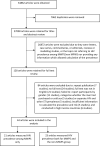The burden of HIV infection among men who purchase sex in low- and middle-income countries - a systematic review and meta-analysis
- PMID: 32886695
- PMCID: PMC7473528
- DOI: 10.1371/journal.pone.0238639
The burden of HIV infection among men who purchase sex in low- and middle-income countries - a systematic review and meta-analysis
Abstract
Background: Since the start of the HIV epidemic, transactional sexual relationships have been considered to present a high risk of HIV transmission to both the client and the person offering the sexual service. However, prevention research and programs have focused predominantly on sex workers rather than on their clients, who are generally men. To support effective and targeted interventions, we undertook a systematic review and meta-analysis of the evidence of the prevalence of HIV infection among men who purchase sex (MWPS) in low- and middle-income countries (LMICs), and the association between HIV infection and purchase of sex.
Methods: We included articles that reported from LMICs on the prevalence of HIV in MWPS and those that reported on HIV prevalence among both MWPS and non-MWPS in the same study, or any information which allowed calculation of the prevalence. We defined MWPS as heterosexual males (not men who purchase sex or individuals of other sexual orientation) who purchased sex mostly from women (and not men), or who have had sexual contact with female sex workers (FSWs). We searched Medline, Global Health, Scopus, Embase and Cinahl for articles published up until 1 March 2020. Meta-analysis was conducted using a random effects model to estimate the pooled HIV prevalence and the relative risk (RR) of HIV infection associated with purchasing sex.
Results: Of 34862 studies screened, we included 44 studies (59515 men, 47753 MWPS) from 21 countries. The pooled HIV prevalence among MWPS was 5% (95%CI: 4%-6%; I2 = 95.9%, p < 0.001). The pooled HIV prevalence calculated from studies that reported data collected pre-2001 was highest, i.e. 10% (95% CI: 6%-14%; I2 = 91.2%, p < 0.001), compared to studies whose data was collected between 2001-2010, i.e. 4% (95%CI: 2%-6%; I2 = 96.6%, p < 0.001), and from 2011 and beyond, i.e. 3% (95% CI: 2%-5%; I2 = 94.3%, p < 0.001). For studies which included comparisons of HIV infection among MWPS and non-MWPS, the relative risk of HIV infection was consistently higher among MWPS than among non-MWPS within the same study, with the overall pooled relative risk of 1.95 (95%CI: 1.56-2.44; I2 = 84.3%, p < 0.001), and 2.85 (95%CI: 1.04-7.76; I2 = 86.5%, p < 0.001) for more recent studies.
Conclusions: This review represents the first comprehensive assessment of the burden of HIV among MWPS in LMICs. We found that HIV prevalence was elevated compared to the population as a whole, and that there was a strong association between purchasing sex and HIV prevalence. Despite a reduction over time in prevalence, these data highlight that MWPS need better access to HIV preventive interventions.
Conflict of interest statement
The authors have declared that no competing interests exist.
Figures





References
-
- World Health Organization. Consolidated guidelines on HIV prevention, diagnosis, treatment and care for key populations– 2016 update. Geneva: World Health Organization; 2016.
Publication types
MeSH terms
LinkOut - more resources
Full Text Sources
Medical

